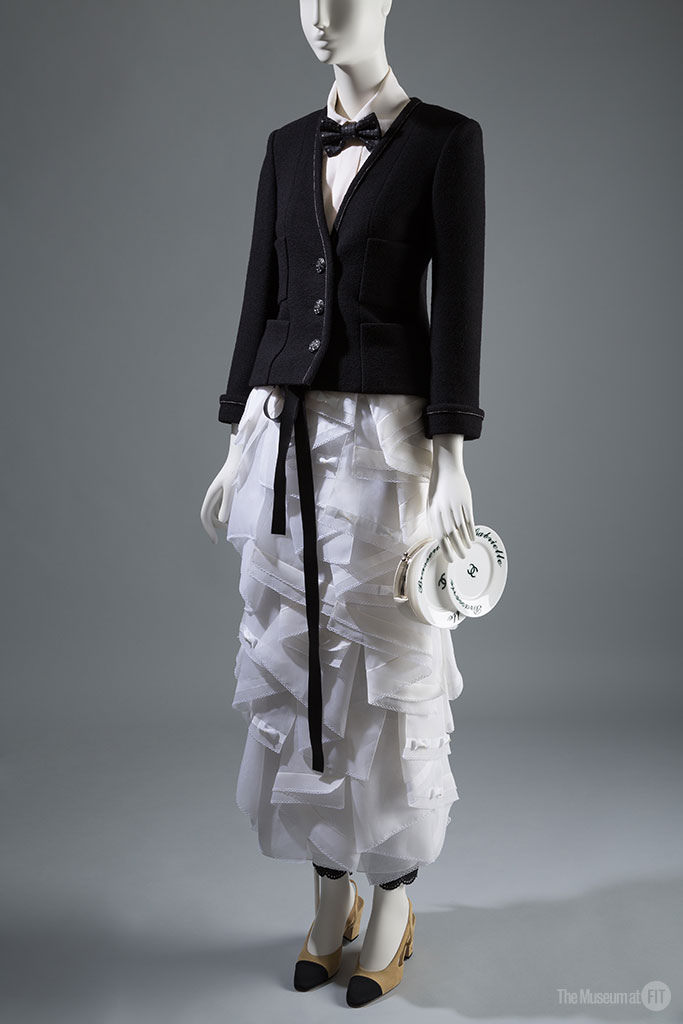Uniformity
The Museum at The Fashion Institute of Technology (New York, NY), May 20-November 19, 2016
Exhibitions intended for a broad public often pose the same open-ended questions to introduce a theme. That is, the same “What is…?” structure art history professors use to initiate pupils into the world of scholarly non-answers.
So, when the Fashion Institute of Technology’s Fashion and Textile History Gallery asked at beginning of its Uniformity exhibition, “What is a uniform?” I couldn’t help think, anything. Luckily, Uniformity furnishes more exact resolutions to the question. By concentrating on a topic so seemingly mundane, Emma McClendon, FIT curator, highlights the social and political prerequisites of standardization, and the fashion industry’s tumultuous love affair with uniforms.
Uniforms protect, establish credibility, double as costumes, invoke God, structure classrooms, and give order to the court. Most certainly they ascertain a person’s placement within the labor chain.
Jeremy Scott’s irreverent McDonald’s golden arch dress for Moschino’s fall 2014 collection made the original, a surprisingly well-tailored women’s polyester McDonald’s uniform dated from 1976, look designer. This was the work of Stan Herman, a key contributor to fashionable workwear in the mid 20th century. His TWA flight attendant uniforms are also featured in this section, along with sharp-looking paragon uniforms made for a housemaid and a chauffeur in the 20th century.
The exhibition keeps to its military, work, school, and sports algorithm in showcasing 71 of FIT’s pieces. Here, you see a Japanese school child’s pleated skirt 12 feet from Chanel’s faux brasserie suit. Rei Kawakubo’s 1988 U.S. army-inspired ensemble for Comme des Garçons is featured in the same room as a Michael Kors camouflage evening gown.
Uniformity emphasizes the military, and moreover, fashion’s infatuation with it. Designers seem to have a knee-jerk proclivity to become inspired by the military in some way, converting soldierly aesthetics to embellish collections. The wide-leg “sailor suit” popularized at the beginning of the 20th century comes in many variations in this section, of which Jean Paul Gaultier is a fan.
High fashion and the military may give and take, but they have been known to collaborate. The exhibition features a uniform for the U.S. Navy’s W.A.V.E.S. (Women Accepted for Volunteer Emergency Service) designed by couturier Mainbocher, which is situated next to a navy Chanel tweed suit with a dropped V neckline from the 1960’s.
Function is obvious in a discussion of uniforms, but often what was once considered efficient would now be the complete opposite. One of the first uniforms in the exhibition is a men’s track outfit dated from the early 20th century, comprised of a tank with very short shorts – quite a contemporary silhouette, save for that it is made entirely of wool.
Other sportswear featured Geoffrey Beene’s “football jersey dress,” made of silk and the number “38” emblazoned in sequins. Collegiate iconography, whether actually affiliated or not, has always held a certain prestige in fashion.
I never had the privilege (or, to some, burden) of wearing a school uniform, and my associations with it oscillate between constriction and camp. The school outfits here do as well, from boxy children’s blazers and pleated knee–length skirts to Rudi Gernreich’s quasi-pornographic “Japanese Schoolgirl” ensemble. I’m sure many private school attendees would disagree, but it can be comforting to have to wear something, albeit convenient when we don’t have to choose what to wear. Uniforms have measurable psychological effects on wearers and viewers alike. Where black uniforms have produced aggression in some, other uniforms yield to a sense of belonging and social stability. [1]
If a given uniform works within a specific, knowledge-based context, then it will inevitably be rendered invalid in a less specifically-literate sphere. To push that hypothesis beyond the western world’s starched utilitarianism, with regard to recent events, it’s hard to imagine someone wouldn’t make an argument for the inclusion of the increasingly banned burqa. As it would need the “fashion” parallel to be included in Uniformity, the chadors from Hussein Chalayan’s spring 1998 collection would have paired well.
A statement at the beginning of the show suggests that uniforms are antithetical to fashion. Uniformity does well to negate its own claim, as does fashion’s recent history. Consider the 1990’s minimalist wave, where Jil Sander, Calvin Klein, and Helmut Lang sent out homogenous swathes of blonde-haired, Eastern European models dressed in sparse cuts and monotone hues. Think about how often the word “clinical” is thrown around in fashion. Could the rampant logomania of the early 2000s also be considered mass standardization?
What is a uniform? The question remains open for debate.
Notes
[1] Mark G. Frank and Thomas Gilovich. “The Dark Side of Self– and Social Perception: Black Uniforms and Aggression in Professional Sports.” Journal of Personal and Social Psychology, Vol. 54, No. 1,74-85. 1988.
All photos by Eileen Costa, courtesy of The Museum at the Fashion Institute of Technology. See more images from the exhibition here.







